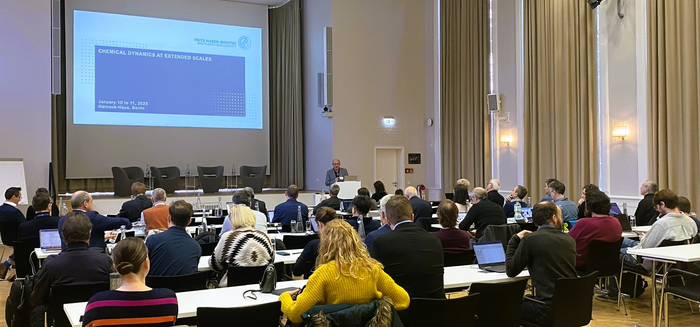The symposium was held at the historical Harnack-Haus and discussed possible future developments the FHI will face with the approaching retirements of three directors (Schlögl, Wolf, and Meijer) in this decade.

Credit: Jelena Tomović
The symposium was held at the historical Harnack-Haus and discussed possible future developments the FHI will face with the approaching retirements of three directors (Schlögl, Wolf, and Meijer) in this decade.
The speakers presented their research and offered answers to not only on questions regarding future challenges asked, but opened the field to a much wider discussion, specially at the guided discussions with our moderators Stefan Hecht, Christoph Koch, Beatriz Roldán, Karsten Reuter and Eberhard Umbach. During and after the talks the focus shifted to the seemingly general questions Why do we do physical chemistry and what questions drive us?
“We stand in front of enormous global problems we have to address. Future research can´t just be curiosity based, it needs to be based on urgent global questions we need to solve. I feel, I don´t have the luxury anymore to be in my laboratory to improve myself as a scientist and not work on imminent problems the world is facing right now and in the near future.” – Iryna Zenyuk
The raised question started fascinating discussions and offered some unique perspectives. The sense, that scientist have to decide between two sides – curiosity driven or application relevant research – doesn´t have to exclude each other. One of the many advantages the Max Planck Society has, is to be able to tackle immanent questions on a broader scale. Having this advantage, the Fritz Haber Institute needs to address what is needed beyond the state-of-the-art. The expectation on the FHI is to create new fields, break new ground and combine theory and experiments on a higher level. To be able to fulfill these expectations as it has always been done at the FHI and to develop even further, the approach on topics, ideas and people needs to become even more divers.
The participants agreed, that chemistry can and hopefully will save the world by providing key technologies for challenges in energy science to battle climate change and to enable recycling of rare materials. Thus physical chemistry has the potential to solve many of the world´s greatest challenges. The answer on how to push discovery and overcome the limits of what we can see and imagine is interdisciplinary cooperation. Encounters like this symposium help to break boundaries and learn from each other. The bridges need to get build even wider – between academia and “the real world”. To get the next generations excited for these questions, is one of the big missions to be achieved.
The symposium was intended to provide some guidance to develop a future research strategy, to discuss cutting-edge research. But it became even more as room was given to reflect on scientific responsibility. The future of the Institute affects not only the scientific community – specifically physical chemistry, but has the opportunity to impact everyday life.
We thank the speakers and participants for this inspiring symposium.
| Speaker | Topic |
| Lydéric Bocquet | Water at the Nanoscales: From Fundamentals of Nanofluidics to Innovations at the Water-Energy Nexus |
| Christophe Copéret | Bridging the Gap Between Single-Sites and Industrial Catalysts via Surface Organometallic Chemistry |
| Abhaya Datye | Taming the Dynamics of Single Atoms in Heterogeneous Catalysts via Atom Trapping |
| Oliver Gessner | Time-Resolved X-Ray Studies of Interfacial Energy and Charge Transfer – What Is Needed Beyond the State-of-the-Art? |
| Frank Glorius | N-Heterocyclic Carbenes on Surfaces and in Membranes – Reaching the Next Level |
| Frank Noé | Fueling the Next Generation of Molecular Simulations with Deep Learning |
| Michele Parrinello | The Dynamical Catalyst |
| Dierk Raabe | Some Ideas about the Material – Chemistry – Mechanics Nexus |
| Ferdi Schüth | Continuously Changing Catalytic Surfaces by Ball Milling |
| Susannah Scott | Directing Molecular Traffic: Controlling Selectivity in Catalytic Reactions by Integrating Reactions with Separations |
| Bert Weckhuysen | Probing Catalytic Materials at Work Across Different Length and Time Scales with Spectroscopy and Microscopy |
| Huolin Xin | Artificial Intelligence and Three-Dimensional In-Situ Transmission Electron Microscopy |
| Iryna Zenyuk | Time-Resolved Synchrotron X-Ray Techniques to Understand the Birth of Electrocatalysts during Pyrolysis Process and the Resulting Functionalities |





